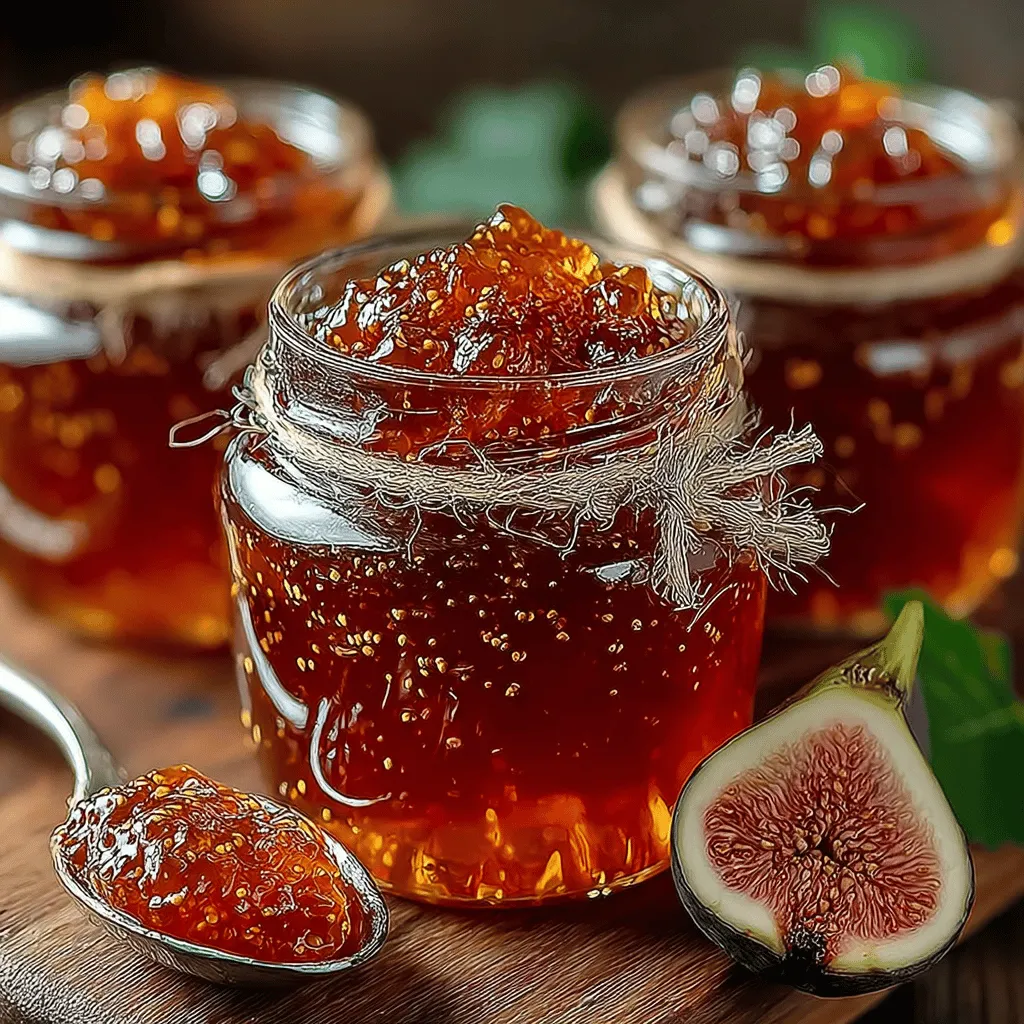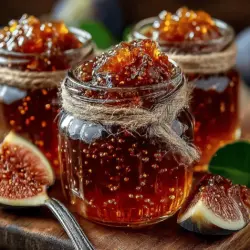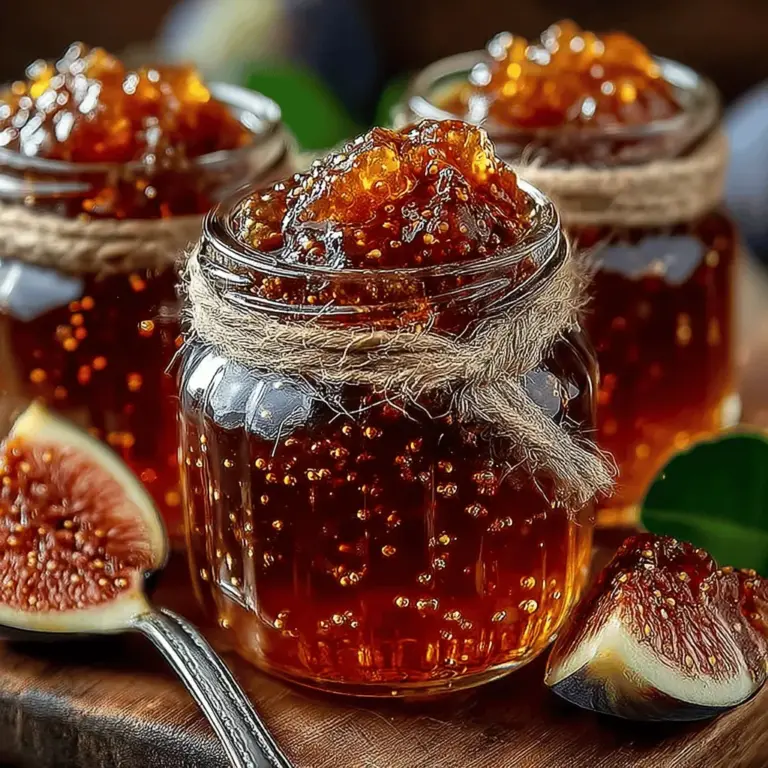Introduction
In the enchanting realm of homemade preserves, few delights can compete with the rich, luxurious flavor of fig jam. This spread, characterized by its unique sweetness and subtle complexity, transforms ordinary dishes into culinary masterpieces. Fig jam is not just a treat for breakfast on toast; it serves as a versatile ingredient that pairs beautifully with a wide array of foods. From complementing artisanal cheeses and charcuterie boards to enhancing savory dishes and desserts, fig jam showcases its adaptability in various culinary settings.
Creating fig jam at home is not only a rewarding endeavor but also an opportunity to embrace the freshness of seasonal ingredients. When you make your own preserves, you have complete control over the quality of the ingredients used, ensuring that only the best flavors are captured. The process of cooking down ripe figs, merging them with sugar and zest, culminates in a product that is far superior to any store-bought version. The satisfaction of crafting your own fig jam—watching it bubble away on the stove and filling your kitchen with its intoxicating aroma—is unparalleled.
Understanding the Ingredients
To appreciate the art of making fig jam, one must first understand the role of each ingredient involved in the recipe. Each component contributes to the final product’s flavor and texture, creating a delicious preserve that can elevate any meal.
Fresh Ripe Figs
The star ingredient of fig jam is, of course, fresh ripe figs. Selecting the right figs is essential for achieving the best flavor. Look for figs that are plump, slightly soft to the touch, and have a vibrant color. The natural sweetness of figs is what makes them an ideal base for jam, and the riper the fruit, the more concentrated the sweetness. When preparing your figs, ensure that they are free from blemishes or mold, as these can affect both the taste and safety of your jam.
Granulated Sugar
Granulated sugar plays a crucial role in the preservation process. Not only does it sweeten the jam, balancing the natural sugars found in the figs, but it also helps to thicken the mixture as it cooks. The sugar acts as a preservative, inhibiting the growth of bacteria and allowing the jam to be stored for longer periods. The right balance of sugar is vital; too little can result in a jam that is overly tart and prone to spoilage, while too much can lead to an overly sweet and cloying final product.
Lemon Juice and Zest
Incorporating lemon juice and zest into your fig jam recipe adds a necessary element of acidity that brightens the overall flavor profile. The acidity not only enhances the sweetness of the figs but also helps to balance the richness of the jam. Lemon juice serves as a natural preservative, contributing to the jam’s longevity, while the zest infuses the mixture with aromatic oils that elevate the taste. Together, they create a harmonious balance that is integral to the jam’s success.
Vanilla Extract
Vanilla extract is an optional yet delightful addition that can elevate the flavor complexity of your fig jam. The warm, sweet notes of vanilla complement the figs beautifully, adding depth and richness to the preserve. When choosing a vanilla extract, opt for pure vanilla rather than imitation, as the quality of the extract will significantly impact the final product.
Ground Cinnamon and Salt
Though optional, ground cinnamon and a pinch of salt can enhance the flavor profile of fig jam. Cinnamon adds a warm, spicy note that pairs remarkably well with the natural sweetness of the figs. Meanwhile, salt serves to amplify the flavors and balance sweetness, making the jam more nuanced. These ingredients can be adjusted to suit personal tastes, allowing for a custom flavor experience.
Preparation Steps for Fig Delight Jam
Now that we have an understanding of the ingredients and their roles, let’s delve into the preparation steps for crafting Fig Delight Jam. This comprehensive guide will walk you through each stage of the process, ensuring clarity and ease as you embark on your jam-making journey.
Preparing the Figs
The first step in making fig jam is the preparation of the figs themselves. Begin by gently washing the figs under cool running water to remove any dirt or impurities. After washing, pat them dry with a clean towel. The next step involves removing the stems; simply cut off the tops of the figs where the stems are attached. Depending on your preference for texture, you can either leave the figs whole, halve them, or chop them into smaller pieces. Keep in mind that smaller pieces will cook down more quickly and result in a smoother jam.
Cooking the Figs
Once your figs are prepared, it’s time to start the cooking process. Transfer the prepared figs to a large, heavy-bottomed pot and allow them to rest for approximately 30 minutes. This resting period is crucial, as it allows the figs to release their natural juices, creating a flavorful base for the jam. After the figs have rested, you can begin to heat them over medium-low heat. Stir occasionally to prevent sticking, and let the figs simmer until they start to break down and soften, which usually takes about 10-15 minutes.
Heating the Mixture
As the fig mixture cooks, it’s essential to maintain a consistent temperature. Gradually increase the heat to medium-high to bring the mixture to a gentle boil. At this point, you can add the granulated sugar, lemon juice, and zest. Stir well to ensure the sugar dissolves completely, and bring the mixture back to a boil. The key to achieving the right consistency for your jam is to manage the heat carefully. A rolling boil will help the mixture thicken properly, while too low of a temperature may result in a watery jam.
Adding Flavor
As the mixture continues to boil, this is the perfect time to incorporate any additional flavors, such as vanilla extract, ground cinnamon, and salt. Adding these ingredients at this stage allows their flavors to meld with the figs as they cook, creating a harmonious blend. Stir the mixture regularly to ensure that the flavors are evenly distributed throughout the jam.
Checking Consistency
One of the most critical steps in making fig jam is checking for the right consistency. To determine if your jam is ready, you can perform a simple test. Place a small plate in the freezer for a few minutes to chill. Once chilled, drop a spoonful of the jam onto the plate and return it to the freezer for about 1-2 minutes. After this time, run your finger through the jam on the plate; if it holds its shape and the line remains clear, your jam has reached the perfect consistency. If it’s still too runny, continue to cook for a few more minutes and repeat the test until you achieve the desired thickness.
With these steps, you’re well on your way to creating a delightful batch of fig jam that embodies the essence of homemade goodness. Stay tuned for Part 2, where we will explore the jarring process and tips for storing your delicious creation!

Jarring and Storing Fig Jam
Once you’ve prepared your delectable Fig Delight Jam, it’s crucial to store it properly to ensure its longevity and safety. This section will guide you through the essential steps for safely jarring your jam so you can enjoy it for months to come.
Preparing Jars
Before you begin jarring your fig jam, you need to prepare your jars. Sterilization is critical for ensuring that your jam remains safe to eat and shelf-stable. Here’s how to do it:
1. Choose Your Jars: Select glass jars with tight-fitting lids. The size can vary based on your preference, but half-pint or pint jars are common choices for jam.
2. Wash Thoroughly: Start by washing your jars and lids in hot, soapy water. Rinse them well to remove any soap residue.
3. Sterilize: There are two effective methods for sterilizing your jars:
– Boiling Method: Place the jars in a large pot of boiling water, ensuring they are fully submerged. Boil for 10 minutes, then carefully remove them and let them cool upside down on a clean dish towel.
– Oven Method: Preheat your oven to 225°F (110°C). Place the clean, wet jars on a baking sheet and heat them for about 10-15 minutes. Be cautious when handling hot jars.
The sterilization process is crucial as it eliminates bacteria that could spoil your jam.
Transferring and Sealing
With your jars ready, it’s time to transfer the fig jam. Follow these tips to ensure a successful transfer:
1. Use a Ladle: Carefully ladle the hot jam into each jar, filling them to about 1/4 inch from the top to allow for expansion.
2. Wipe the Rims: After filling, use a clean, damp cloth to wipe the rims of the jars. This step is essential for creating a proper seal and preventing contamination.
3. Seal the Jars: Immediately place the sterilized lids on top of the jars. Screw on the metal bands until they are fingertip-tight, but don’t overtighten as this can prevent air from escaping during the sealing process.
Cooling and Storing
Once your jars are filled and sealed, it’s time to cool and store them properly:
1. Cooling: Allow the jars to cool completely at room temperature. You may hear popping sounds as the jars seal, which is a good sign that they are creating a vacuum seal.
2. Check the Seal: After cooling, check the seals by pressing down in the center of each lid. If it doesn’t pop back, the jar is sealed correctly. If it does, refrigerate the jar and use it within a few weeks.
3. Long-term Storage: If sealed properly, your fig jam can be stored in a cool, dark place, such as a pantry, for up to a year. Once opened, keep the jar in the refrigerator and consume within a few weeks.
By following these steps, you can ensure that your homemade fig jam remains delicious and safe to eat for an extended period.
The Benefits of Homemade Jam
Homemade fig jam not only offers a delightful culinary experience but also comes with multiple benefits compared to store-bought options.
Health Considerations
One of the most significant advantages of making your own fig jam is the health aspect. When you prepare jam at home, you have complete control over the ingredients. This means you can avoid preservatives and artificial flavors commonly found in commercial jams. You can also tailor the sweetness to your liking, using natural sweeteners like honey or maple syrup if desired, making it a healthier option for you and your family.
Customization
Another perk of homemade fig jam is the ability to customize flavors. Whether you prefer a sweeter jam, a spicier kick with cinnamon, or the tanginess of lemon zest, you can adjust the recipe to suit your taste. This level of personalization is often lacking in store-bought products, where flavors are standardized.
Sustainability
Making fig jam with locally sourced, seasonal ingredients not only supports local farmers but also reduces your carbon footprint. By choosing fresh, organic figs and minimal packaging, you contribute to a more sustainable food system. Moreover, it’s an excellent way to utilize surplus fruit, reducing waste and encouraging a more mindful approach to food.
Creative Ways to Use Fig Jam
Once you’ve mastered the art of making fig jam, the next step is to explore its culinary versatility. Here are some creative ways to incorporate fig jam into your meals.
Breakfast Ideas
Start your day on a delicious note by incorporating fig jam into your breakfast routine. Here are a few ideas:
– Toast: Spread a generous layer of fig jam on warm, crusty bread or a toasted bagel. For an added touch, top with cream cheese or ricotta.
– Pancakes and Waffles: Drizzle fig jam over pancakes or waffles for a sweet and fruity twist. Pair it with a dollop of whipped cream or Greek yogurt for a satisfying breakfast.
– Yogurt Parfaits: Layer fig jam in a parfait with yogurt and granola. The combination of creamy yogurt, crunchy granola, and sweet jam makes for a nutritious and energizing breakfast.
Savory Pairings
Fig jam isn’t just for sweet dishes; it can elevate savory meals too. Consider these pairing ideas:
– Cheese Platters: Pair fig jam with a selection of cheeses for an impressive cheese board. It complements creamy cheeses like Brie, tangy goat cheese, or sharp cheddar perfectly.
– Glaze for Meats: Use fig jam as a glaze for roasted meats such as chicken or pork. Mix it with balsamic vinegar or soy sauce for a rich, flavorful coating that adds depth to your dishes.
– Charcuterie Boards: Incorporate fig jam into your charcuterie boards as a sweet contrast to cured meats and pickles. It offers a delightful balance of flavors that guests will love.
Desserts
Finally, fig jam can be a delightful addition to various desserts. Here are some sweet ideas to try:
– Pastries: Use fig jam as a filling for pastries like Danish or hand pies. The sweet and sticky texture pairs wonderfully with flaky pastry.
– Tarts: Spread fig jam in a tart shell and top with fresh fruits, nuts, or a crumb topping for an elegant dessert.
– Ice Cream Topping: Warm fig jam slightly and drizzle it over vanilla ice cream for a simple yet indulgent dessert. The warm jam adds a beautiful contrast to the cold ice cream.
Conclusion
Making Fig Delight Jam at home is more than just a rewarding culinary project; it’s an opportunity to embrace the rich flavors of seasonal fruit while enjoying the numerous benefits of homemade preserves. From the health advantages of controlling ingredients to the joy of customizing flavors, every step of the process is gratifying.
We encourage you to experiment with your variations, whether adding spices, adjusting sweetness, or trying different fruit combinations. As you savor the fruits of your labor, you’ll discover how versatile fig jam can be in your culinary adventures. So, gather your ingredients, follow the steps, and relish in the joy of homemade fig jam that will elevate your meals and delight your taste buds!

